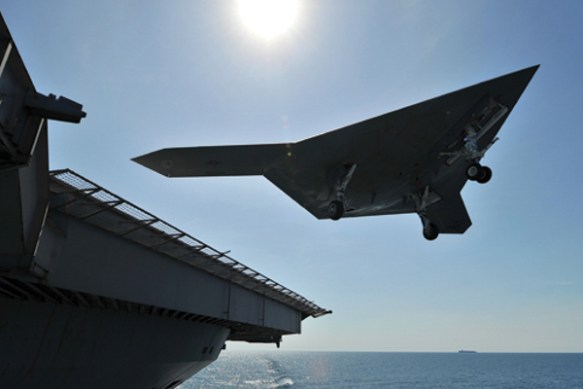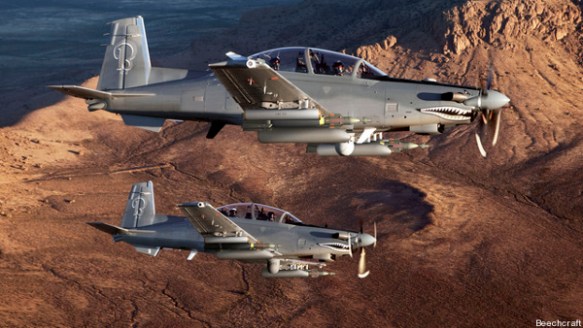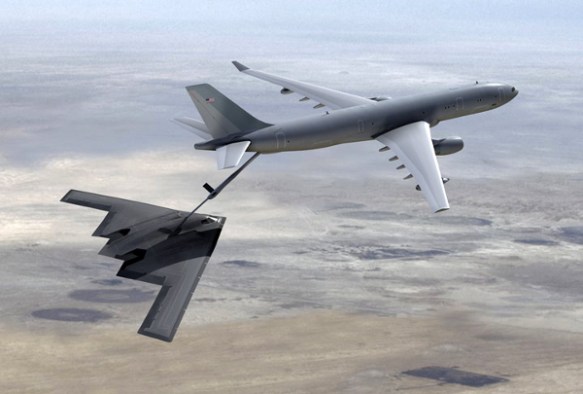Fight Begins Over Navy’s Armed Drone Program.

© 2013 National Defense Industrial Association
This is a really good article. Not only is the title intended to tempt in readers in much the same way as ‘Navy UAV takes on mud-wrestling’ might do but it is effective in that intent… The touch and go flight that was recently successfully conducted aboard the USS George HW Bush is a real advance in unmanned aircraft (UA) technology. As I stated at the time, the earlier catapult launching of the X-47B was a bit of a non-event as a block of concrete can be successfully launched by an aircraft carrier catapult, after which it flies in accordance with its design specifications.
The touch and go was probably even more of a challenge than the arrested landing on a carrier that has yet to occur. This is because an arrested landing is exactly that – the aircraft will stop (arrest) whether it really wants to or not (unless it’s an F-35C where the hook may or may not engage or simply bounce over the wire). In a touch and go, the UA must land on the carrier, remained aligned with the flight deck and take off again until its own power – no catapult-assisted kick in the rear to help out.
Now we are starting to see some real operating concepts being rolled out for an unmanned combat aircraft (UCA??) that give us some idea of how such a capability may be employed to complement the manned component of an aircraft carrier’s air wing and, by inference, the manned component of other air combat forces. Unfortunately the fight mentioned in the title is not over how we will use UCAs but more over who might build them and does the builder of the concept development platform have an unfair advantage over other contenders for the production run. This resurrects shades of the USAF KC-X tanker and light attack aircraft trainer (LAAT) programmes where the bigger issue was not which was the best aircraft for the role but who was going to make to damn things…

AT-6 Texan II

KC-46 refuelling a B-2 © 2013 National Defense Industrial Association
UCLASS will operate autonomously most of the time, but a pilot will control the aircraft during critical mission segments. Ultimately, Lockheed wants its design to allow one operator to fly as many as four aircraft at the same time, he said. “There’s going to be inherent systems aboard the aircraft and in the loop that will ensure safe separation” between the drones.
There are some interesting themes in this short paragraph…
“…will operate autonomously most of the time, but a pilot will control the aircraft during critical mission segments…” Please define ‘autonomously’: does this mean that the UCA will operate ‘most of the time’ thinking for itself, making its own decisions on how it will conduct tasks in the a similar manner to how the pilot/crew of a manned aircraft conduct themselves? Watch out, Skynet, here comes the competition!! Or, does it mean that the UCA will operate automatically for those portions of its mission where a human operator is not required, for example, during long transits through permissive (no credible bad guys) airspace or other ‘boring stuff’? One of the biggest problems facing the UA community is the misuse of UA-related terminology within the military and by the media and the public. We may not be able to do too much about the latter two but we can certainly get it right within our own communities…autonomous ≠ automatic!!
“…to allow one operator to fly as many as four aircraft at the same time…” Uh-huh…just how will this work when things get ‘busy’? I would say that this task would be a challenge akin to chainsaw-juggling (engines revving) and would question whether the human mind, even assisted by notional AI and the best situational awareness tools available will be severely challenged to keep track of multiple UCAs performing anything more than the most mundane of ‘bus-driving’ tasks…
“…between the drones…” OMG, see the point about getting the terminology right…a drone in nature and in technology is just that – why do you think it is not considered exactly complimentary to refer to someone as a ‘drone’? A drone is a semi-expendable minion, not noted for its ability for free thought or great displays of initiative. A military drone is something like the Teledyne Ryan ones flown over Vietnam et al in the 60s, or the good old CL-289 taught to glazed-eye tactics students during the Cold War.

A ‘drone’ is not the interactive, responsive tool that most contemporary UA are, even those acquired from Toyword, Ebay, or Trademe. We really need to square away the semantics within the UAS community so that we can sing off the same sheet of music to the uninitiated and not simply muddy the waters further. If this doesn’t come from the UAS community, it will be inflicted upon it by those unaware and uninitiated who think a drone is something to be afraid of – not because it is so dumb but because it might (apparently) take over the world…
So let’s keen an eye on progress with the X-47B and the upcoming US UCA competition but let’s also not be so blinded by its coolness that we don’t forget our own responsibilities towards enlightenment and responsibility.


I agree 100% , I am posting just about the same idea on my Fb, incredibly people like to use terms and ideas that are completely nonsense… like using drone word for every unmmaned vehicle, basic difference, drones do not take off by themselves.
LikeLike